
Page 5 of 5
Bison in a Snowstorm
When I woke up the next morning and looked outside through our small, ground-level window, I saw only the blur of white blowing snow. We piled into Bombardiers – old-fashioned, classic snow coaches – with our gear and headed out on our last day in the park, following the Firehole River through the Midway and Lower Geyser Basins. It snowed hard off and on all day.
We stopped at the Fountain Paint Pots to follow a trail around colorful hot springs, geysers, fumaroles and bubbling mud pots. It was fiercely cold and windy, but the snow had paused while we were there.
Later in the morning as we traveled on, the snow began again and the day became gray and dark. We began to encounter long lines of bison moving along the road, heads down in the heavily falling snow. This forced our vehicles and several others to move at no more than a crawl and often to come to a stop. Long lines of snowmobiles had stopped completely, waiting for the bison to pass.
In the gray, obscure light and snow, it was a strange and eery sight and went on for a very long time in what seemed like slow motion, with lines of bison plodding slowly up the road ahead, big heads swinging, and walking past our windows, often only inches away. It was at least an hour, maybe two, before our snow coach finally, very slowly and cautiously, crept past the last of the bison.
We followed the Firehole River, its waters warmed and kept open by the thermal activity in the area, a beautiful, narrow, snaking, fast-flowing stream, dark steel-gray, with snowy overhanging banks and snow-pillowed rocks.
Trumpeter Swans on the Madison River
After stopping for lunch in a warming hut, we continued north and came to the Madison River, also dark, steel gray-green, but a wider, bigger river, flowing over rocky bottom and boulders between steep banks of snow.
It was here we began to see Trumpeter Swans, so picture-perfect they looked unreal, like something out of a fairy tale – huge swans, with wingspans of more than six feet and long, elegant, muscular necks. Pure white, with ink-black bills, they floated serenely with necks held straight and tall, or sometimes curved in the classic swan-shape, dipping their heads deep and long into the water to feed on vegetation. We stopped once or twice to watch them, and as we drove on, following the Madison River, we saw many more floating in its waters, including young, grayish cygnets.
Barrow’s Goldeneye
In the Madison River we also found ducks – buffleheads, northern pintails, ring-necked ducks and American widgeon. But for me the highlight was finally getting a good look at Barrow’s goldeneye, perhaps a signature species of this part of Yellowstone in winter. A compact black-and-white diving duck, with – in the male – black head, white breast and belly, black wings marked with several dashes of white, a distinctive white crescent on the face – and a bright golden eye, which I have to say we could not see very well, though all the other markings were clear.
It began to snow heavily again as we drove on – all day, it would seem like a blizzard, then the sun came out and blue sky appeared, then snow would return.
Bald Eagles
We saw a number of bald eagles during our trip, mostly along the rivers, but a sighting on this last afternoon was by far the most spectacular.
We were still following the Madison River, heading north toward the west entrance to the park. Betsy spotted a bald eagle along the river, being harassed by a raven. We stopped to get a better look, and very soon saw not one, but two adult bald eagles fly to a perch in an evergreen tree. The raven stopped in another tree nearby. Then we saw a third eagle – an immature – in the middle of the evergreen tree with a duck in its talons. As we watched, the young eagle leaned down and tore off a beak-full of duck – and feathers flew, scattered by the wind across the snow. A few drifted to where we stood, and Betsy identified them as goldeneye feathers.
Meanwhile, the two mature bald eagles put on quite a show. Against a sky that had become brilliant blue, in crisp clear light, one flew, then the other, just over the tree-line and not far away. Sunlight shone on their white heads, and through their white tails. And they called to each other loudly and repeatedly.
As it turned out, this dramatic sighting marked the end of our winter week in Yellowstone. We soon left the park and drove to a lodge in Big Sky, where we spent the last night of the trip.
Rough-legged Hawks
The drive the next morning seemed in some ways unreal. A blurry gray sky, and off and on snow and mist shrouded the changing contours of the mountains. A raven soared over the high brown turret of a peak. Much of the way we followed the Gallatin River, a dark, glistening ribbon of water tumbling over rocks and boulders through the frozen stillness of the snow. At times there were gentle rapids, and at times I could see the brownish rocky bottom of the stream. In more open stretches, as we came down, bare, pale brown aspens, cottonwoods and willows lined the river’s banks. We passed two more bald eagles, goldeneye ducks and three American dippers flying low over the water – and one dark-gray dipper sitting on a small snow-cushioned rock in the middle of the flowing river.
We began to see a few homes, ranches and other structures and American magpies flashing black and white, flying from fencepost to trees or poles. We watched for moose in the willows along the river, and finally saw one – a cow feeding on what appeared to be shrubbery near a garage on one of the many houses by this time lining the road.
My attention was mostly taken by several sightings of rough-legged hawks – “our winter hawk,” Betsy said. Maybe partly because of the misty gray light, they appeared as an almost white-on-white bird against the landscape, mottled with brown but ghostly pale, echoing the pattern of snow-covered plains stubbled with brown grass and shrubs, flying low on long, slender wings, with a white, spread tail and black band at the edge. We had seen one or two on our drive the first day, from Bozeman into the mountains, but not very well, so I was happy to see several in the last hour or so of our trip. They seemed to materialize all along the way, though always just out of reach, just out of focus, fading into white.
We began to come into small towns and strip development mixed with ranch land, the majestic, snow-covered peaks now in the distance, but all around. Burger King, Exxon, McDonalds, several casinos, an IGA market, a shopping center, traffic lights . . . we all commented on the shock of returning to “civilization.” We turned into the airport and suddenly were gathering up our luggage and jackets, saying brief goodbyes, and our small group scattered to flights in all directions.
![]()

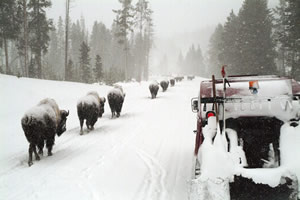
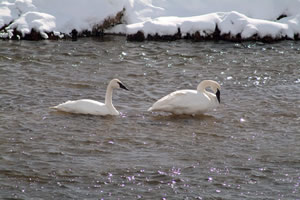
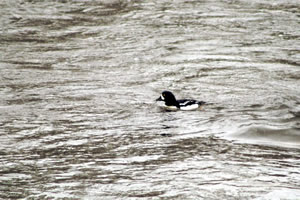
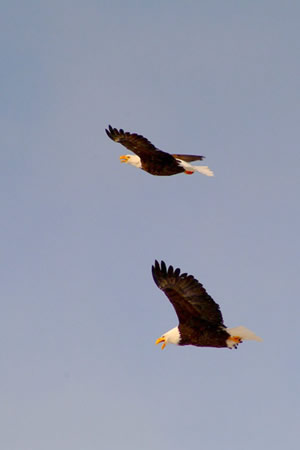
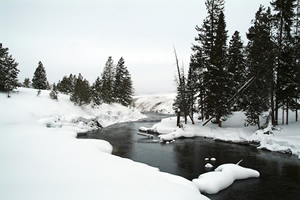
Copyright © 2009 Sigrid Sanders| All Rights Reserved